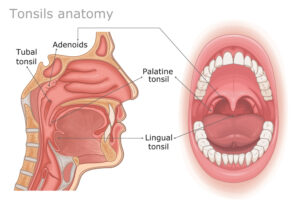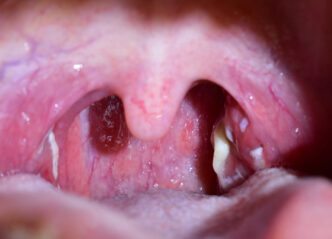Tonsillitis is a common problem, especially in children, but not every sore throat is a sign to rush for surgery. Do you know what your tonsils actually do or when they really need to come out? From understanding how tonsillitis happens to knowing when a tonsillectomy is necessary, here are four important facts to keep in mind.
WORDS ASSOCIATE PROFESSOR DR HARDIP SINGH GENDEH
 FEATURED EXPERT FEATURED EXPERTASSOCIATE PROFESSOR DR HARDIP SINGH GENDEH Lecturer and Specialist Ear, Nose & Throat Surgeon Department of Otorhinolaryngology, Head and Neck Surgery Faculty of Medicine Universiti Kebangsaan Malaysia |
#1 WHEN TO REMOVE AND WHEN TO KEEP?

Tonsillitis is, simply put, an infection of the tonsils, causing them to become enlarged and swollen.
- Someone with tonsillitis will experience pain in their throat.
- Difficulty in swallowing, fever, and sore throat are also commonly experienced during a tonsillitis episode.
Removing the tonsils is one possible treatment for tonsillitis.
Remove or Keep?
For one-off or infrequent infections, the conventional medical advice is to keep the tonsils.
- The doctor will identify the cause of the tonsillitis and treat the possible source(s) of infection.
- They will also prescribe appropriate treatments to manage the pain.
The American Academy of Otorhinolaryngology, Head and Neck Surgery only recommends a tonsillectomy (the surgery to remove the tonsils) when a person experiences:
- Recurrent tonsillitis for 7 or more times per year in the past 12 months
- Recurrent tonsillitis for 5 times or more per year for the past 24 months
- Recurrent tonsillitis for 3 times or more per year for the past 36 months
The abovementioned cases may be associated with high fever, swelling of the lymph nodes on the neck, and whitish exudates from the tonsils.
Exceptions to the Rule
Children with recurrent tonsillitis that affect their ability to attend school regularly
- Frequent absences from school may eventually affect their academic performance.
- Concerned parents may consult an ENT specialist for consideration of a tonsillectomy for such a child.
The person also experiences febrile fits
- Tonsillitis may cause high fever.
- The spike in body temperature can lead to a type of seizure called febrile fits.
- While such fits can eventually go away on their own, recurrent fits may lead to damage and injuries to the brain.
People with obstructive sleep apnoea caused by enlarged tonsils
- Enlarged tonsils can narrow the airway at the back of the mouth and thus limit the passage of air to the lungs while the person is sleeping.
- The blood carries less oxygen, and the brain receives less oxygen as a result.
- This leads to obstructive sleep apnoea (OSA), a condition in which the sleeping person goes through a cycle of stopping and resuming breathing.
- OSA may be detrimental to one’s health if left untreated.
- Doctors will rule out other possible causes of OSA before recommending tonsillectomy to a patient.
| Join Associate Professor Dr Hardip as he explains more about OSA in this article. |
Other circumstances that are best addressed by a tonsillectomy
These include:
- Chronic (long-term) tonsillitis accompanied by sore throat and foul breath.
- Tonsillitis due to infection by Group B beta-haemolytic Streptococci.
- Enlarged tonsil on one side or asymmetrical tonsils, which could be a sign of cancer (lymphoma or squamous cell carcinoma).
- Presence of pus collected around the tonsillar bed (peri-tonsillar abscess), which can cause
- muffled voice and swelling of the soft palate (the tissue at the back of the mouth).
Tonsillectomy may also be prescribed along with other operative procedures to address issues such as OSA or to allow a surgeon access to a patient’s deep neck spaces (parapharyngeal space) from the back of the mouth.
| Some patients may also have enlarged adenoids (lymphatic tissue at the back of the nose) — these will be removed together with the tonsils during a tonsillectomy. |
#2 THERE ARE SEVERAL TONSILLECTOMY METHODS
Tonsillectomy is a procedure whereby the lymphatic tissue forming the palatine tonsils is dissected away from the throat or the pharynx.
This procedure is performed via either of the following methods.
Cold Instruments
- This is the most conventional method.
- The surgeon uses a tonsillar dissector and a snare to remove the tonsils.
- The resulting bleeding is stopped with a suture knot.
Powered Instruments
- The surgeon will use a device heated by electric currents (electrocauterization) to ‘burn’ away or separate the tonsils and stop the resulting bleeding.
- Alternatively, the surgeon may use specialized vibrating scalpels called ultrasonic scalpels, which utilize ultrasonic vibrations to remove the tonsils and stop the bleeding.
- May cause less bleeding, but there is a higher degree of charring of the tissues surrounding the now-removed tonsils.
Some ENT surgeons may combine both methods by using cold instruments to remove the tonsils and electrocauterization to control the bleeding.
#3 PAIN AND BLEEDING AFTER THE SURGERY
Those undergoing tonsillectomy must be aware that there is a possibility that the pain experienced after the surgery may result in decreased food and fluid intake.
Bleeding within the First 24 Hours
- When the patient’s food and fluid intake is reduced, there is a higher possibility of debris building up in the tonsillar bed — the site of operation — and increasing the chances of bleeding at that area.
- Such bleeding, called post-tonsillectomy bleeding, may occur within 24 hours. Doctors call such bleeding a primary bleed.
Bleeding After 24 Hours or Up to 2 to 3 Weeks after the Surgery
- Such bleeding is called a secondary bleed.
- Secondary bleeds are often caused by an infection that arises as a result of reduced food and fluid intake.
Post-tonsillectomy bleeds are not common, but when they occur, they are considered medical emergencies and may require surgery to stop the bleeding.
If one experiences such bleeding, they should seek medical attention immediately.
#4 DO THESE WHEN YOU HAVE TONSILLITIS BUT DO NOT REQUIRE A TONSILLECTOMY IMMEDIATELY
- For pain control, simple paracetamol and topical pain control medications (either chewables, gargle, or spray) can be obtained from a doctor or over the counter.
- However, for more severe and prolonged infection, a visit to the general practitioner will be necessary, as they can prescribe stronger painkillers such as non-steroidal anti-inflammatory drugs (NSAIDs) and administer a course of antibiotics.
- Children or adults with significantly reduced oral intake due to pain in swallowing are at risk of dehydration; when that occurs, they should be admitted into the hospital for fluid transfusion and appropriate medications.
Signs of Dehydration to Watch Out For
Children
- Dry mouth and tongue
- Little to no tears produced while crying
- Lack of or infrequent urination — in babies, long periods of time without wet diapers
- Sunken eyes and cheeks
- Listlessness, irritability, and other unusual changes in behavior
Adults
- Prolonged, severe thirstiness
- Lack of or infrequent urination
- Dark-coloured urine
- Lack of energy (fatigue)
- Dizziness and/or confusion
| This article is part of our series on health issues related to the ear, nose, and throat. |














